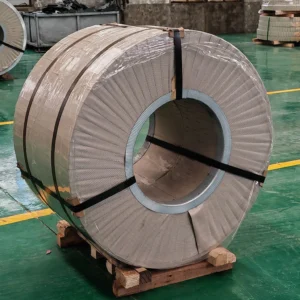Introduction
The modern world relies on a constant and reliable supply of electricity. From residential consumption to industrial operations and from data centers to renewable energy integration, the demand for efficient power transmission is growing rapidly. To achieve higher levels of efficiency and sustainability, the materials used in transformer manufacturing play a crucial role. Among these, cold rolled grain oriented steel has become indispensable. This specialized electrical steel is engineered to reduce core losses, improve transformer performance, and support the transition toward a more energy-efficient global power grid.
Understanding Cold Rolled Grain Oriented Steel
Cold rolled grain oriented steel (CRGO) is a type of electrical steel characterized by a highly controlled grain structure that enhances its magnetic properties. Unlike non-oriented steel, CRGO is processed to align grains in a specific direction, which minimizes hysteresis losses and improves magnetic permeability. This makes it the ideal material for transformer cores, where energy efficiency and low loss are critical.
The development of CRGO in the early 20th century transformed the electrical industry. Its introduction enabled manufacturers to design transformers that were smaller, lighter, and significantly more efficient. Today, CRGO remains a foundation of energy infrastructure across Europe, North America, and the Middle East.
Manufacturing Process
Producing CRGO steel involves a series of sophisticated steps:
- Hot Rolling: Steel slabs are rolled at high temperatures into thinner sheets.
- Cold Rolling: The steel is further processed at room temperature to achieve the required thickness.
- Decarburization Annealing: This reduces carbon content and improves magnetic properties.
- Secondary Recrystallization: Grain orientation is developed to achieve high permeability.
- Application of Coatings: Insulation coatings are added to reduce eddy current losses and improve stacking in transformer cores.
The precision of each step ensures that CRGO steel achieves low core loss and high magnetic efficiency.
Key Properties
The widespread use of cold rolled grain oriented steel is due to its unique properties:
- Low Core Loss: Ensures high energy efficiency.
- High Magnetic Flux Density: Enables effective magnetic conduction.
- Durability: Provides long-term reliability for transformers.
- Thin Gauge: Allows for compact transformer designs.
- Sustainability: Reduces wasted energy, contributing to lower CO₂ emissions.
Applications in the Power Industry
CRGO steel is primarily used in the cores of transformers. Its applications include:
- Power Transformers: Handling high-voltage electricity between generation and transmission.
- Distribution Transformers: Ensuring stable electricity delivery to end-users.
- Renewable Energy Transformers: Supporting solar and wind power projects.
- Specialized Transformers: Used in railways, large-scale industrial plants, and smart grids.
In Europe, CRGO supports the shift toward renewable energy and energy-efficient systems. In the Middle East, rapid urbanization and infrastructure expansion are creating high demand for reliable transformers. Globally, the material ensures stable power delivery in diverse operating environments.
International Standards and Grades
CRGO steel is manufactured to meet global standards, including:
- IEC 60404 – International standards for magnetic materials.
- ASTM A876 – U.S. standards for electrical steel.
- JIS C2553 – Japanese standards for oriented steel.
Grades vary based on thickness and performance, with advanced options such as laser-scribed CRGO offering further reductions in energy losses.
Market Dynamics and Demand
The global demand for cold rolled grain oriented steel is expanding due to:
- Rising electricity consumption worldwide.
- Modernization of transmission and distribution networks.
- Adoption of renewable energy systems.
- Government regulations on energy efficiency.
In Europe, sustainability initiatives are driving CRGO demand. In the Middle East, major infrastructure projects and industrial growth require transformers built with CRGO cores. North America emphasizes grid modernization, further strengthening the market outlook.
Cost and Long-Term Value
Although CRGO steel is more expensive to produce compared to non-oriented steel, its long-term benefits outweigh initial costs. Transformers made from CRGO last longer, consume less energy, and require less maintenance. For utilities and industries, these savings translate into improved operational efficiency and lower total cost of ownership.
Environmental Contribution
Energy transmission losses account for significant waste worldwide. By reducing core losses in transformers, CRGO steel helps lower overall electricity wastage. This not only improves system efficiency but also reduces greenhouse gas emissions, supporting climate action goals in Europe, the Middle East, and beyond.
Future Outlook
The future of CRGO is tied to global energy trends. With the rapid adoption of renewable energy, smart grid technologies, and electrification of transport, demand for high-efficiency transformers will continue to grow. Advances in CRGO production are expected to yield even thinner gauges and lower core losses, reinforcing its position as a vital material in the energy sector.
Conclusion
Cold rolled grain oriented steel is a cornerstone of modern electrical infrastructure. Its superior magnetic properties, ability to reduce energy loss, and role in enhancing transformer performance make it indispensable in today’s energy-dependent world. For Europe, North America, and the Middle East, CRGO ensures reliable, efficient, and sustainable power distribution. As the energy sector evolves, this material will remain at the center of global electrification and efficiency efforts.




